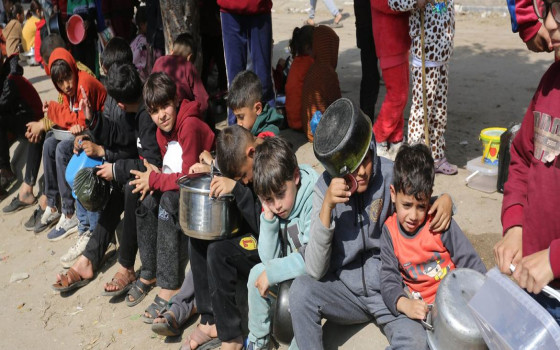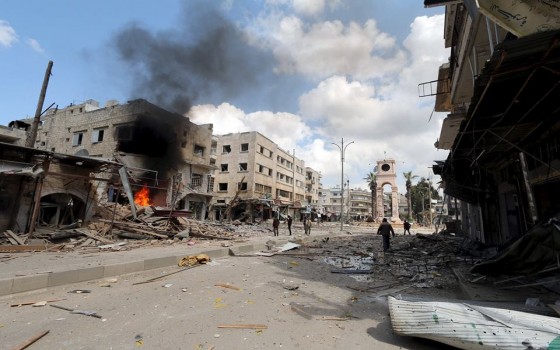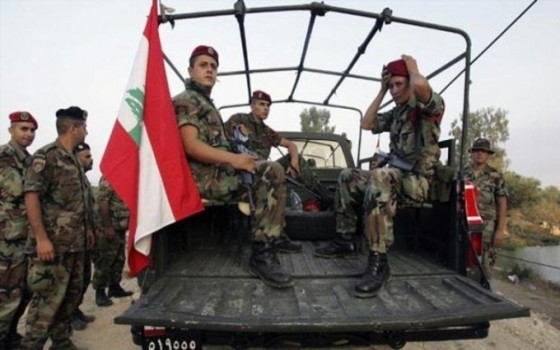
Gaza children suffer from hunger and malnutrition, threatening their present and future

- Europe and Arabs
- Friday , 3 January 2025 9:1 AM GMT
Gaza: Europe and the Arabs
Words cannot describe the tragedy that the Palestinian people in the Gaza Strip are going through. People’s means of survival are being dismantled, humanitarian access is facing obstacles, prevention and attacks, the health sector is receiving fatal blows, and many people have no shelter to protect themselves from the harsh winter cold. According to the UN news bulletin, a copy of which we received this morning, which also stated, “The residents here smell a foul odor in the midst of a tragic situation that has been ongoing for about 16 months. It is a mixture of gunpowder from shells, bullets and raids that have been raining down on the Strip day and night, the piled-up garbage that has formed new terrain and landmarks everywhere, and the death that has affected every home and taken lives that are difficult to accurately count, while thousands of bodies are still under the rubble. As if this scene was not enough, the specter of famine looms over the entire Strip, as 96 percent of women and children cannot meet their basic food needs, according to UNICEF. Although the Global Partnership for the Integrated Food Security Phase Classification lacks sufficient access to accurately assess the nutritional situation in Gaza, the classification indicates that conditions are ripe for the worst possible scenario to come true: famine spreading throughout the Gaza Strip, affecting its two million people between November 2024 and April 2025.
As UNICEF’s Executive Director said, “Children did not start this conflict and they have no power to stop it, yet they are paying the ultimate price with their lives and their futures.”
“Misk withers”
One of these children is Misk Al-Madhoun. She is suffering from severe acute malnutrition, her weight has plummeted from nine to about four kilograms, and she continues to lose weight as the innocent child withers and dries up before her parents’ eyes. A UN News correspondent met Misk and her family at a center for displaced people west of Deir al-Balah in central Gaza.
Her father sat next to her, holding her little brother, his eyes filled with sadness and grief as he watched the apple of his eye, barely able to catch her breath.
Her mother, who was holding her, described the circumstances that led to Misak reaching this state, saying: "We were displaced from the north to Rafah, and after the invasion of the area, we moved to Deir al-Balah, where we lived in a tent. My daughter suffered from a daily temperature of more than 40 degrees Celsius. We would take her in the middle of the night to the American hospital, which only provided her with basic painkillers. My daughter reached this state due to the large displacement and lack of food and money. Our financial situation was better before the war, thank God, but because of the war and displacement, my husband's work stopped, and he was no longer able to provide us with food and drink. This is why my daughter suffers from severe malnutrition."
Her mother told us that her daughter cannot sleep, and that she constantly wakes up to her bitter reality, while her condition worsens with each passing day. She said: "The malnutrition she suffers from is so severe that she no longer has an appetite for food. Even after receiving treatment and therapeutic foods, her weight continues to decrease."
In a scene that reflects the tragic humanitarian reality in the Strip, dozens of Palestinian women and their children flocked to a local medical clinic run by the Terre des Insane association with support from UNICEF, to conduct medical examinations for their children, most of whom suffer from malnutrition.
In a conversation with a UN News correspondent, Dr. Mohammed Al-Agha, the supervising physician at the medical center located in the Za’arub camp in the Al-Mawasi area west of Khan Younis, explained the efforts undertaken by the association, saying: “At this point, we follow up on the nutritional status of the children. We currently have approximately two hundred admissions for children suffering from acute and chronic malnutrition. We follow up weekly, and we contact the families if they miss their appointments, thanks to the comprehensive support from UNICEF.”
In addition to in-patient care, the association supports families in this camp by treating hundreds of other children suffering from moderate malnutrition and guiding their parents to avoid the worst-case scenario using the limited resources available to them.
Once self-sufficient in eggs, milk, meat and vegetables, acute malnutrition in Gaza is now at alarming levels, 10 times higher than before 7 October 2023.
Among children aged 6-59 months, 60,000 cases of acute malnutrition, including 12,000 severe cases, are expected between September 2024 and August 2025.
In general, malnutrition among children leads to severe, lifelong consequences that may be irreversible, including stunting, poor cognitive development, weakened immune systems and increased risk of death from common diseases.
In addition to continuing its efforts to provide humanitarian assistance to the people of Gaza, the United Nations calls for an immediate ceasefire, the release of hostages and ensuring the necessary large-scale access and distribution of humanitarian assistance throughout the Gaza Strip.












No Comments Found